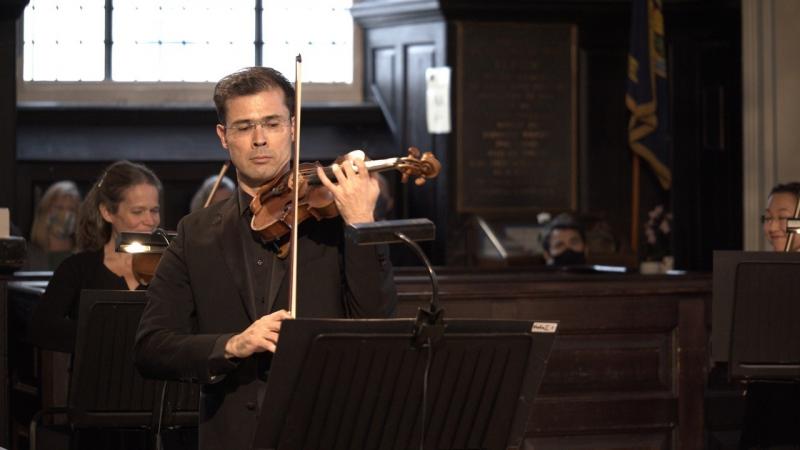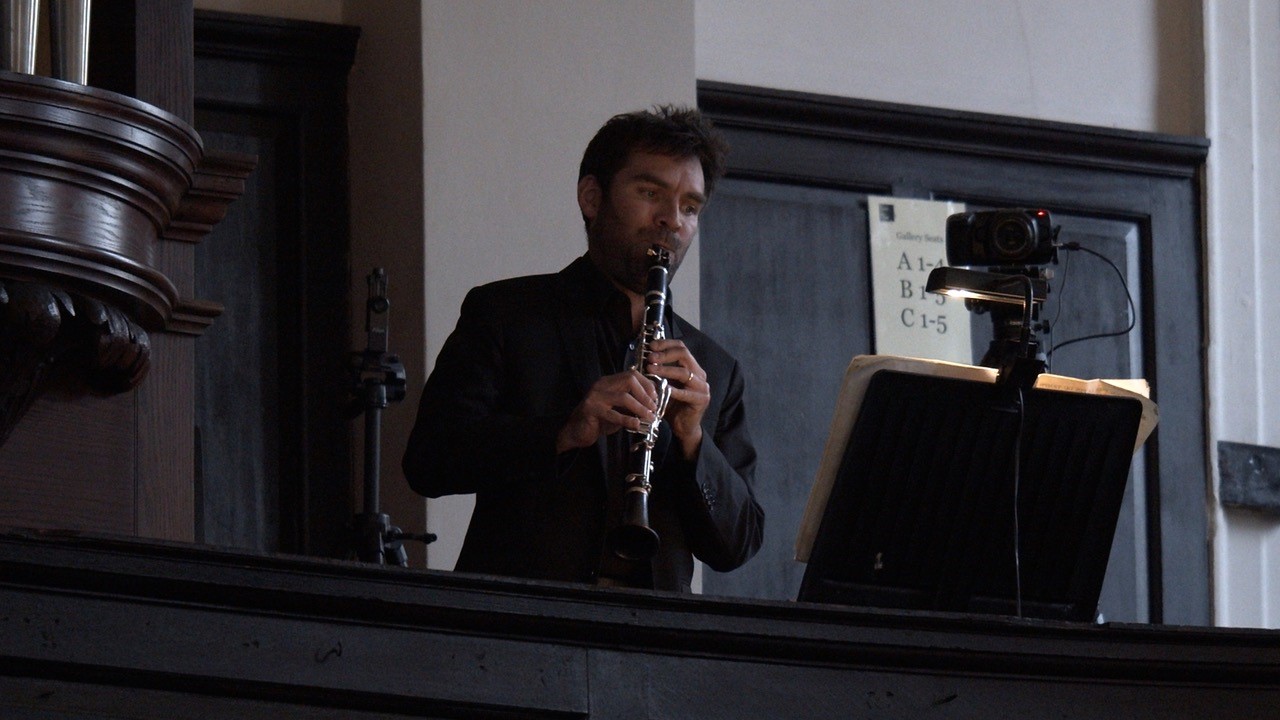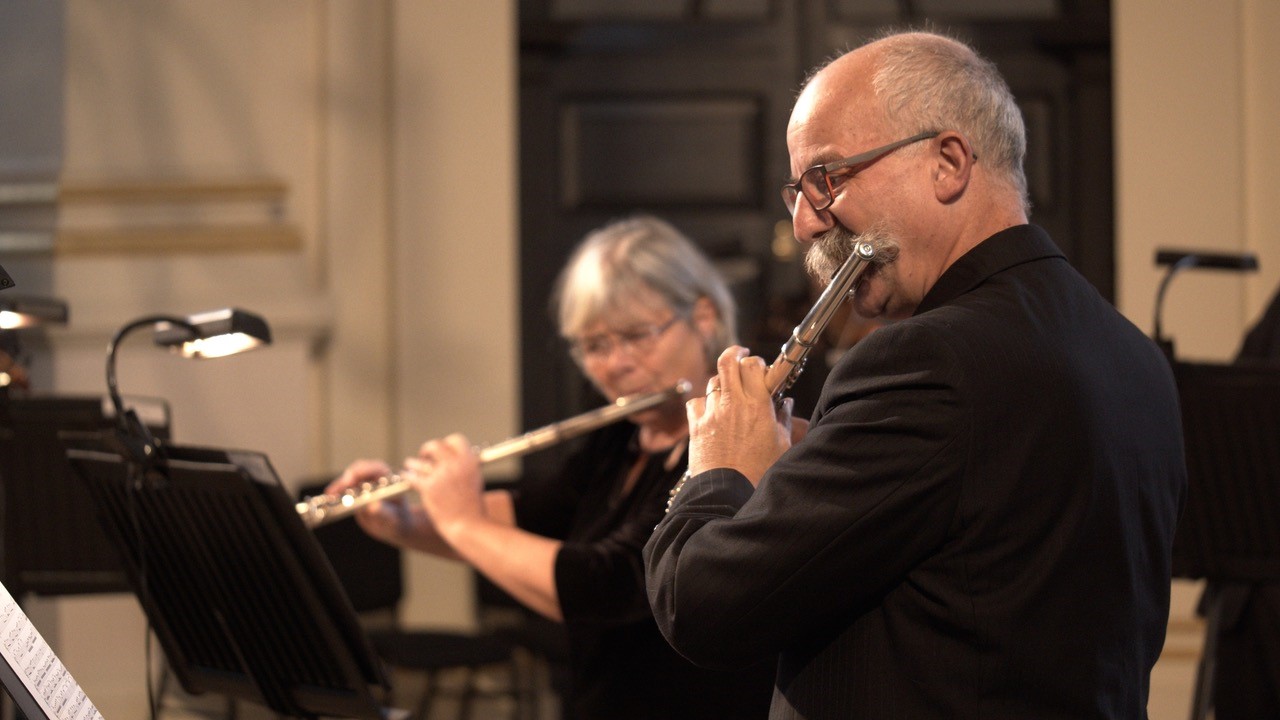Academy of St Martin in the Fields review - from solo meditations to collective celebrations | reviews, news & interviews
Academy of St Martin in the Fields review - from solo meditations to collective celebrations
Academy of St Martin in the Fields review - from solo meditations to collective celebrations
Messiaen and MacMillan prompt reflection, while ensemble Bach and Mozart dance

Clearly it takes peculiar circumstances for some of us to hear the Academy of St Martin in the Fields within its eponymous church – that’s a first for me. The lure was considerable.
Three Orpheuses (Orphei?) led the way in to meditative depths while straggling groups of Covidiots from the Trafalgar Square ‘protest’ stumbled noisily away outside (most had already moved on to Hyde Park). The pity came first, Will Schofield going straight to the heart of the matter with the mourning-space of Bach’s Sarabande from the Fifth Cello Suite.  Clarinettist Thomas Lessels answered it from the organ gallery (pictured below) with tritones and other disturbing intervals in Messiaen’s "Abime des oiseaux"(Abyss of birds) from the Quartet for the End of Time; St Martin’s acoustics helped make stunning work of the swells on single notes from ppp to fff.
Clarinettist Thomas Lessels answered it from the organ gallery (pictured below) with tritones and other disturbing intervals in Messiaen’s "Abime des oiseaux"(Abyss of birds) from the Quartet for the End of Time; St Martin’s acoustics helped make stunning work of the swells on single notes from ppp to fff.
The third in this compellingly interconnected trilogy came from Stephen Stirling, pulling plainsongs of praise out of the hat in the horn interlude from MacMillan’s Since it was the day of Preparation... Joyful high frequencies almost blinded us, if you’ll forgive the mixing of the senses, in the first ensemble piece, Bach’s Fourth Brandenburg Concerto. Within the vibrant dances of the outer movements, flautist Michael Cox (pictured below with second flautist Sarah Newbould) and leader Tomo Keller found a freedom on the edge of risk; it worked.  In terms of a full programme without interval, Copland’s Quiet City felt a bit like a number too far for some of us in the live audience; online, you can pause when you want. And in any case its pertinence was as strong as when the BBC Symphony Orchestra featured it in their First Night of the Proms, though quite different in feel; there, projecting into the void, here once again establishing calm against the odd police siren and other noises outside. Again the soundspace worked beautifully for trumpeter Alan Thomas and cor anglais player Rachel Ingleton. Mozart’s Symphony No. 29 resumed the dancing strain of the Bach, Keller’s strong leadership keeping the adrenalin rush of the finale focused in its brilliance. You couldn’t help but be lifted out of any introspection by this journey from thoughtful semi-darkness into blazing light.
In terms of a full programme without interval, Copland’s Quiet City felt a bit like a number too far for some of us in the live audience; online, you can pause when you want. And in any case its pertinence was as strong as when the BBC Symphony Orchestra featured it in their First Night of the Proms, though quite different in feel; there, projecting into the void, here once again establishing calm against the odd police siren and other noises outside. Again the soundspace worked beautifully for trumpeter Alan Thomas and cor anglais player Rachel Ingleton. Mozart’s Symphony No. 29 resumed the dancing strain of the Bach, Keller’s strong leadership keeping the adrenalin rush of the finale focused in its brilliance. You couldn’t help but be lifted out of any introspection by this journey from thoughtful semi-darkness into blazing light.
rating
Explore topics
Share this article
The future of Arts Journalism
You can stop theartsdesk.com closing!
We urgently need financing to survive. Our fundraising drive has thus far raised £49,000 but we need to reach £100,000 or we will be forced to close. Please contribute here: https://gofund.me/c3f6033d
And if you can forward this information to anyone who might assist, we’d be grateful.

Subscribe to theartsdesk.com
Thank you for continuing to read our work on theartsdesk.com. For unlimited access to every article in its entirety, including our archive of more than 15,000 pieces, we're asking for £5 per month or £40 per year. We feel it's a very good deal, and hope you do too.
To take a subscription now simply click here.
And if you're looking for that extra gift for a friend or family member, why not treat them to a theartsdesk.com gift subscription?
more Classical music
 Solomon, OAE, Butt, QEH review - daft Biblical whitewashing with great choruses
Even a top soprano and mezzo can’t make this Handel paean wholly convincing
Solomon, OAE, Butt, QEH review - daft Biblical whitewashing with great choruses
Even a top soprano and mezzo can’t make this Handel paean wholly convincing
 Two-Piano Gala, Kings Place review - shining constellations
London Piano Festival curators and illustrious friends entertain and enlighten
Two-Piano Gala, Kings Place review - shining constellations
London Piano Festival curators and illustrious friends entertain and enlighten
 Echo Vocal Ensemble, Latto, Union Chapel review - eclectic choral programme garlanded with dance
Beautiful singing at the heart of an imaginative and stylistically varied concert
Echo Vocal Ensemble, Latto, Union Chapel review - eclectic choral programme garlanded with dance
Beautiful singing at the heart of an imaginative and stylistically varied concert
 Scott, Irish Baroque Orchestra, Whelan, RIAM, Dublin review - towards a Mozart masterpiece
Characteristic joy and enlightenment from this team, but a valveless horn brings problems
Scott, Irish Baroque Orchestra, Whelan, RIAM, Dublin review - towards a Mozart masterpiece
Characteristic joy and enlightenment from this team, but a valveless horn brings problems
 Classical CDs: Voice flutes, flugelhorns and froth
Baroque sonatas, English orchestral music and an emotionally-charged vocal recital
Classical CDs: Voice flutes, flugelhorns and froth
Baroque sonatas, English orchestral music and an emotionally-charged vocal recital
 Kanneh-Mason, Britten Sinfonia, Shave, Milton Court - a grin and a big beaming smile
A pair of striking contemporary pieces alongside two old favourites
Kanneh-Mason, Britten Sinfonia, Shave, Milton Court - a grin and a big beaming smile
A pair of striking contemporary pieces alongside two old favourites
 theartsdesk at the New Ross Piano Festival - Finghin Collins’ musical rainbow
From revelatory Bach played with astounding maturity by a 22 year old to four-hand jazz
theartsdesk at the New Ross Piano Festival - Finghin Collins’ musical rainbow
From revelatory Bach played with astounding maturity by a 22 year old to four-hand jazz
 First Person: Manchester Camerata's Head of Artistic Planning Clara Marshall Cawley on questioning the status quo
Five days of free events with all sorts of audiences around Manchester starts tomorrow
First Person: Manchester Camerata's Head of Artistic Planning Clara Marshall Cawley on questioning the status quo
Five days of free events with all sorts of audiences around Manchester starts tomorrow
 Goldscheider, Brother Tree Sound, Kings Place review - music of hope from a young composer
Unusual combination of horn, strings and electronics makes for some intriguing listening
Goldscheider, Brother Tree Sound, Kings Place review - music of hope from a young composer
Unusual combination of horn, strings and electronics makes for some intriguing listening
 theartsdesk Q&A: composer Donghoon Shin on his new concerto for pianist Seong-Jin Cho
Classical music makes its debut at London's K-Music Festival
theartsdesk Q&A: composer Donghoon Shin on his new concerto for pianist Seong-Jin Cho
Classical music makes its debut at London's K-Music Festival

Add comment